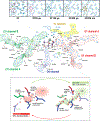Capturing the sequence of events during the water oxidation reaction in photosynthesis using XFELs
- PMID: 36310373
- PMCID: PMC9839502
- DOI: 10.1002/1873-3468.14527
Capturing the sequence of events during the water oxidation reaction in photosynthesis using XFELs
Abstract
Ever since the discovery that Mn was required for oxygen evolution in plants by Pirson in 1937 and the period-four oscillation in flash-induced oxygen evolution by Joliot and Kok in the 1970s, understanding of this process has advanced enormously using state-of-the-art methods. The most recent in this series of innovative techniques was the introduction of X-ray free-electron lasers (XFELs) a decade ago, which led to another quantum leap in the understanding in this field, by enabling operando X-ray structural and X-ray spectroscopy studies at room temperature. This review summarizes the current understanding of the structure of Photosystem II (PS II) and its catalytic centre, the Mn4 CaO5 complex, in the intermediate Si (i = 0-4)-states of the Kok cycle, obtained using XFELs.
Keywords: X-ray free-electron laser; X-ray spectroscopy; manganese metalloenzymes; oxygen evolving complex; photosystem II; water-oxidation/splitting.
© 2022 Federation of European Biochemical Societies.
Conflict of interest statement
Funding sources and disclosure of conflicts of interest
Funding sources are in the acknowledgements. There are no conflicts of interest.
Figures



References
-
- Hillier W, and Messinger J (2005) Mechanism of photosynthetic oxygen production, in Photosystem II: The light-driven water:plastoquinone oxidoreductase, eds. Wydrzynski T, Satoh K, Springer.
-
- Shevela D, Kern JF, Govindjee G, Whitmarsh J, and Messinger J (2021) Photosystem II, in eLS, John Wiley & Sons, Ltd, pp. 1–16.
-
- Barty A, Caleman C, Aquila A, Timneanu N, Lomb L, White TA, Andreasson J, Arnlund D, Bajt S, Barends TRM, Barthelmess M, Bogan MJ, Bostedt C, Bozek JD, Coffee R, Coppola N, Davidsson J, DePonte DP, Doak RB, Ekeberg T, Elser V, Epp SW, Erk B, Fleckenstein H, Foucar L, Fromme P, Graafsma H, Gumprecht L, Hajdu J, Hampton CY, Hartmann R, Hartmann A, Hauser G, Hirsemann H, Holl P, Hunter MS, Johansson L, Kassemeyer S, Kimmel N, Kirian RA, Liang M, Maia FRNC, Malmerberg E, Marchesini S, Martin AV, Nass K, Neutze R, Reich C, Rolles D, Rudek B, Rudenko A, Scott H, Schlichting I, Schulz J, Seibert MM, Shoeman RL, Sierra RG, Soltau H, Spence JCH, Stellato F, Stern S, Strüder L, Ullrich J, Wang X, Weidenspointner G, Weierstall U, Wunderer CB, and Chapman HN (2012) Self-terminating diffraction gates femtosecond X-ray nanocrystallography measurements. Nature Photon, 6 (1), 35–40. - PMC - PubMed

